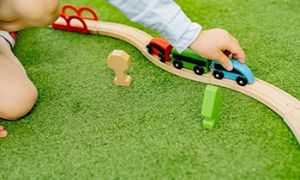Effective communication is key to building positive relationships with children and facilitating their learning. However, if our words are to have the desired impact, they need to be adequately complemented with non-verbal cues. This is even more pertinent in the early childhood contexts when young children are yet to fully acquire language. The following article provides strategies for using non-verbal communication with children.
Make Eye Contact
One of the easiest ways to intentionally practice positive non-verbal communication is to improve eye contact. When speaking to children, be sure to connect with them visually with a wide, natural and open gaze. On your part, this conveys to the child, “you are important to me and I am giving you my full attention”. On the child’s part, such eye contact makes it easier to understand non-verbal cues to understand, making your verbal message more ‘readable’.
Speak At The Child’s Level
When speaking, bend or sit down so that you are at the child’s level. For one, this makes an adult appear less intimidating and more approachable. Also, this helps you to stay close which is especially helpful for younger children to feel reassured and loved.
Watch Your Space
Indeed space as a non-verbal form of communication does not get attention but it having an understanding of how it can be used to communicate needs and feelings can play a big part in children’s development, especially their social skills. For example, a child might be standing very close to a friend and the friend might look uncomfortable, or start stepping back. You could gently remind the child to give their friend some space – for example, ‘Carly, let’s give Jacob a bit more room by taking a step back. Well done, Jacob’s got more space now. Later, if you find the child being mindful of others’ space, be sure to notice and praise the behaviour, for example, ‘Carly, I like the way you gave Emile some space to stack the boxes on the table’.
Keep An Open Posture
When people hold their arms to the side, as opposed to crossed or wrapped around the body, it conveys a greater receptivity to what others have to say. Adopt a similar open posture when speaking to your learners so that they feel free to share their thoughts and ideas with you. Also, be aware of how much you move since actions like walking about in the room can interfere with the teacher-child connection while pacing up and down can communicate stress and anxiety to children. Instead adopt a grounded, relaxed posture to show the children that you are engaged in talking to them.
Smile More Often
There are few non-verbal cues that are more effective at making connections than open, sincere smiles. As you talk, ask questions and discuss, ensure that you adopt positive facial expressions so that children feel more comfortable opening up to you.
Practice Reflective Expressions
Use your expressions to let children know that you understand how they feel. For example, if a child smiles at you, give them a broad smile in return. If your child is sad, nod your head and look sad yourself. Though reflective expressions can often take the form of such mirroring, consider what is appropriate for each occasion. For example, if a child appears to be frustrated, the right way to respond would be to make eye contact and use a calm, reassuring tone of voice.
Gestures Count
Head nods, thumbs up, and hands up in excitement are powerful non-verbal cues that express positive engagement with children. You can also lightly touch a child’s arm to let your child know you’re interested and you care about what they’re saying or doing. Again if a child likes to be cuddled, ensure they get plenty of those!
Pay Joint Attention
Among the most effective non-verbal communication strategies is joint attention which involves two people intentionally paying attention to the same thing such as an object, other people, an event or even a concept. When adults practice joint attention with children, the latter are more deeply engaged with the matter at hand. For example, if a child spills something, rather than telling them to clean it up, if an adult gets down on the floor with the child to wipe a mess together, there will be more effective learning on the part of the child. Indeed research has found joint attention to be useful in facilitating learning in young children, particularly in vocabulary building.
Consider Vocal Cues
Use a pleasant tone of voice when speaking to children and include vocalizations like “uh-uh” or “hmm-hmm” to show that you are actively listening to them. As far as possible practice high-pitched, child-directed speech with varying rhythms to build positive engagement with children. Known as “motherese” this speech pattern has been found to help children identify where words begin and end. Research also shows that it can help them identify sounds, syllables, words, and even sentences.
When To Use Non-verbal Communication
All the above strategies make it clear that non-verbal cues can be effectively used in a wide range of situations:
- To nurture secure, loving relationships with children like using smiles, eye contact and gentle touch for positive engagement
- To facilitate learning like paying joint attention when playing literacy matching games or practising routines.
- To stand in for verbal communication when distance or noise makes it hard to talk. For example, you might give a child a smile and a ‘thumbs up’ when they get an award on the school stage or help a friend in the playground.
- To guide a child’s behaviour. Thus if you see a child behaving in an inappropriate manner, you can use your facial expression and body language to send a message. For example, you might shake your head or put your hand up to signal ‘stop’. Maintaining consistent eye contact, adopting a low tone of voice and bending down to your child’s level are other useful ways of conveying the message that you do not approve of the way the child is behaving. Speak in a clear, firm tone – for example, ‘Jaz, you’re being too rough with your friends. Please keep your hands to yourself. In case they still don’t look at you, you can clasp their hand to get their attention
What To Keep In Mind When Using Non-verbal Communication
Practice teaching - To improve non-verbal communication between you and children, it is greatly important to be aware of the non-verbal cues you are sending out. For example, if your “good morning” or “how was your weekend” is merely parroted without a smile or expression of genuine interest, then children are unlikely to connect with you. Also remember that children learn most by watching their significant adults so no matter how carefully your social skills learning strategies are designed if children don’t see you practising good non-verbal communication with them, they are unlikely to learn to use appropriate body language when interacting with peers. So pay close attention to various aspects of your non-verbal language and see which areas you might find it easier to introduce changes. For instance, you may intentionally school your face to be softer and more open when you talk to your kids. Yes, this may feel a little unnatural at first, but the response you get will eventually make it well worth the effort!
Consider additional needs – Children with some type of additional needs like find it challenging to communicate – whether using verbal or non-verbal methods. For example, children on the autism spectrum may not like to make eye contact in which case educators will have to take a call on how much to adjust to their learning style and how far to get them to practice such communication. One of the ways to do the latter is to hold objects you know the child wants right in front of your eyes. You can keep doing this until the child automatically looks up when they want something. Likewise, children with certain types of sensory sensitivities might find body contact like hugging difficult. To communicate warmth or approval to these children, you can use gestures or actions like clapping, winking or giving a thumbs-up.
Sync your verbal and non-verbal cues – for effective communication, both verbal and non-verbal cues should complement each other. This is especially important when modelling correct behaviour before children or guiding their behaviour. So, for instance, if a young child says something funny but also unacceptable, educators and families should avoid laughing which shows tacit approval. instead, keep a straight face and use a firm tone to say something like ‘In our class, we speak to each other politely’. Children are more likely to understand that their behaviour isn’t acceptable if their words match their body language.
Further Reading
EYLF Learning Outcome 5: Children Are Effective Communicators - The following lists the sub-outcomes, examples of evidence when children can achieve each sub-outcome and how educators can promote and help children to achieve EYLF Learning Outcome 5: Children Are Effective Communicators.
Improving Language Skills In Children - The following provides strategies for how to encourage language in children from 0 to 8 months.
Active Listening - The article provides information on What Active Listening Is, Active Listening Definition, Active Listening Skills Examples and more.
References:
Non-Verbal Communication Skills, A Fine Parent
Importance Of Communication With Children, Medical Xpress
Non Verbal Communication, Raising Children







 As an Educator in Australia, your pay rate falls under the Children’s Services Award 2010. This award states the minimum amount that an employer can
As an Educator in Australia, your pay rate falls under the Children’s Services Award 2010. This award states the minimum amount that an employer can When working as a qualified Early Childhood Teacher (with a university degree) within a service, your rate of pay will come from the Educational Services
When working as a qualified Early Childhood Teacher (with a university degree) within a service, your rate of pay will come from the Educational Services When working as a Diploma Qualified Educator your pay rate is from the Children's Services Award 2010. This Award states your minimum rate of pay
When working as a Diploma Qualified Educator your pay rate is from the Children's Services Award 2010. This Award states your minimum rate of pay When working as a Cert 3 Qualified Educator, your pay rate is from the Children's Services Award 2010. This Award states your minimum rate of
When working as a Cert 3 Qualified Educator, your pay rate is from the Children's Services Award 2010. This Award states your minimum rate of Educational Leaders play a crucial role in their early childhood service by ensuring that the educational program aligns with best practices and supports the holistic
Educational Leaders play a crucial role in their early childhood service by ensuring that the educational program aligns with best practices and supports the holistic In early childhood education and care, ratios are more than a technicality—they are a frontline safeguard. Every child deserves responsive supervision, emotional connection, and developmental
In early childhood education and care, ratios are more than a technicality—they are a frontline safeguard. Every child deserves responsive supervision, emotional connection, and developmental Here’s a comprehensive Mobile Phone and Smart Watch Policy tailored for early childhood education and care (ECEC) services in Australia, aligned with the latest 2025
Here’s a comprehensive Mobile Phone and Smart Watch Policy tailored for early childhood education and care (ECEC) services in Australia, aligned with the latest 2025 With the new national child safety reforms kicking in on 1 September 2025, early childhood services like yours have a real opportunity to lead the
With the new national child safety reforms kicking in on 1 September 2025, early childhood services like yours have a real opportunity to lead the The Sea of Fish Challenge is a national initiative that invites children, educators, families, and communities to create and display fish artworks as a symbol
The Sea of Fish Challenge is a national initiative that invites children, educators, families, and communities to create and display fish artworks as a symbol Across the early childhood education and care sector, educators are sounding the alarm: current staffing ratios are insufficient to deliver safe, meaningful, and developmentally appropriate
Across the early childhood education and care sector, educators are sounding the alarm: current staffing ratios are insufficient to deliver safe, meaningful, and developmentally appropriate


